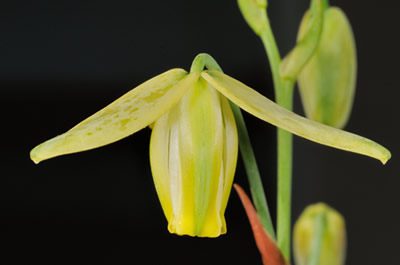The Corkscrew Albuca (Albuca spiralis ‘Frizzle Sizzle’) is a cultivar of a bulbous and succulent plant native to South Africa, where it grows in both sandy and clayey soils, from Namaqualand, Cape Peninsula, and Karoo. Its leaves are very peculiar; in addition to being succulent, they have a linear shape, bluish-green color, and curled tips, resembling a corkscrew. The leaves appear in the autumn-winter and fall after the plant blooms and bears fruit, completing its cycle in late spring when the plant goes dormant.
In mild climates, the Corkscrew Albuca can become perennial and retain its leaves year-round. The flowers are yellowish-green and hang in pendulous inflorescences that rise above the foliage. It is said to have a sweet fragrance reminiscent of vanilla and butter. The flowering period can last up to 30 days. The plant has glandular hairs on the leaves and at the base of the inflorescence.

The Corkscrew Albuca has been very successful in interior decoration. However, it is important to emphasize that for the curled effect of its leaves, the Corkscrew Albuca needs to receive a good amount of direct sunlight during its growth in the autumn. In hotter locations, it can be protected around noon. Once the leaves have developed, it can be placed in a well-lit indoor window. It can be planted in pots or directly in the garden in well-drained beds, complementing rocky, contemporary, and desert-inspired gardens.

It should be grown in full sun or partial shade, in well-drained soil suitable for succulent plants. During its growth and throughout the vegetative period, it requires regular watering so that the substrate dries superficially between waterings. After the onset of dormancy, the substrate should remain completely dry until the beginning of autumn when it can be irrigated again.
Be cautious with organic fertilization and the pot’s drainage; excess moisture can lead to bulb rot. This bulb can be planted more superficially, with its neck above the ground. It can tolerate low temperatures down to 19.4°F (-7°C), but it does not tolerate frost. Fertilize during autumn and winter with soluble fertilizer once a month. It can be propagated from seeds.

